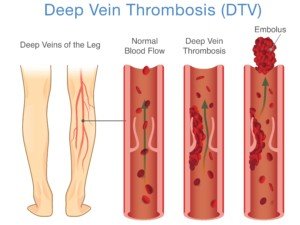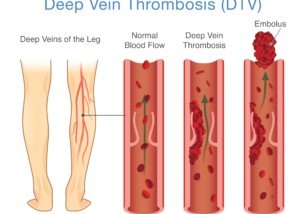Not all deep vein thromboses resolve with the aid of drugs, especially when they are long and dense.
“DVT stands for deep venous thrombosis, which represents abnormal blood clotting in the veins, usually involving the lower extremities,” says Morton Tavel, MD, Clinical Professor Emeritus of Medicine, Indiana University School of Medicine, and author of “Health Tips, Myths and Tricks: A Physician’s Advice.”
Dr. Tavel explains, “The main problem originating from this disorder is the detachment of parts or all of these venous clots breaking off and landing upstream in the lungs, resulting in a potentially dangerous pulmonary embolus (PE).”
This is a blood clot in the lung that requires immediate treatment.
“The DVT itself will ordinarily resolve without the need for removal, and the treatment of this problem is aimed at preventing further clotting through the use of various anticoagulants,” says Dr. Tavel.
But sometimes a deep vein thrombosis is particularly dangerous: dense and long.
In 2013 a 62-year-old patient presented at the ER of Ronald Reagan UCLA Medical Center with shortness of breath and other symptoms.
A CT scan showed a two foot long DVT which began from his legs and went into his heart.
A clot busting drug was no match for this monster. The man’s doctor referred to the 24 inch long DVT as a “wad of gum in a pipe.”
Dr. John Moriarty told the patient that the only other options were open heart surgery or AngioVac—a vacuum procedure.
The patient chose the minimally invasive AngioVac. A week later he was back home.
How was this dense, very long DVT removed?
- A tiny camera went down the patient’s esophagus so that doctors could see his heart.
- A coiled hose was guided through his neck; one end of this hose was plugged into the patient’s heart, against the DVT.
- Then, the hose’s other end was threaded through a groin vein.
- Then the hose was hooked up to a heart-bypass device which created suction.
The AngioVac sucked up this ultra-long deep vein thrombosis from the heart. The device “filtered out solid tissue,” points out Dr. Moriarty in the report.
It “restored the cleansed blood through a blood vessel near the groin.” No need for a blood transfusion.
The procedure lasted three hours. The clot buster (tPA) would have taken three or maybe four days to work.
Here is more information on AngioVac — a mechanical means for the removal of fresh, soft deep vein thromboses.

Dr. Tavel’s medical research includes over 125 publications, editorials and book reviews in peer-reviewed national medical journals. He was formerly director of the cardiac rehabilitation program at St. Vincent Hospital in Indiana. mortontavel.com
 Lorra Garrick has been covering medical, fitness and cybersecurity topics for many years, having written thousands of articles for print magazines and websites, including as a ghostwriter. She’s also a former ACE-certified personal trainer.
Lorra Garrick has been covering medical, fitness and cybersecurity topics for many years, having written thousands of articles for print magazines and websites, including as a ghostwriter. She’s also a former ACE-certified personal trainer.
.














